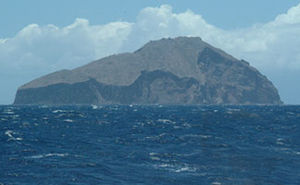Redonda: Difference between revisions
Tag: references removed |
|||
| Line 32: | Line 32: | ||
*{{loc}} |
*{{loc}} |
||
*{{CIA World Factbook}} |
*{{CIA World Factbook}} |
||
* [http://www.redonda.org/ www.redonda.org/] |
|||
==External links== |
==External links== |
||
Revision as of 17:42, 22 November 2010

Redonda is a very small, uninhabited Caribbean island or islet which is part of Antigua and Barbuda,[1] in the Leeward Islands, West Indies.
This small island lies 56.2 kilometres (34.9 mi) southwest of Antigua, in the waters between the islands of Nevis and Montserrat. Redonda is closer to Montserrat than to any other island; it is located at 22.5 kilometres (14.0 mi) northwest of Montserrat, and 32 kilometres (20 mi) southeast of Nevis.
Redonda is essentially one very large rock. It is the remnant of an ancient volcanic core, and the land rises extremely steeply from sea level, mostly as sheer cliffs. Although to Columbus the island appeared to be round, it is in reality long and narrow in outline. The actual land area of the island is hard to calculate because of the extreme steepness of the slopes, but is estimated as somewhere between 1.6 square kilometres (400 acres) and 2.6 square kilometres (640 acres). The highest point is 296 metres (971 ft). Redonda is uninhabited, except by seabirds and a flock of feral goats that manage to survive on the poor grazing on top of the island.

History
Christopher Columbus discovered Redonda in 1493 on his second journey. He claimed it for the Spanish crown, but did not land there. He named the island Santa María la Redonda, meaning Saint Mary the Round, reflecting the island's apparent profile when viewed from the side. In the 1860s, the island became a British possession.
During the decades after the 1860s, the rich guano (phosphine oxide) deposits of Redonda were mined for fertiliser, with an annual yield of up to 7,000 tons. Only during this time was the island inhabited, by workers. The population was 120 in 1901. During the First World War, the mining operations ceased, and the workers left the island, which has remained uninhabited since then. Two stone huts still stand from the time when the island was occupied. Redonda became a dependency of Antigua and Barbuda in 1967.
Scientists from the Montserrat Volcano Observatory[2] visit the island in a helicopter periodically; they are using Redonda as an observation point from which to take measurements of the Soufrière Hills active volcano on Montserrat. The only postcard of Redonda was published by Kimagic[3]
The micronation
Redonda is internationally known, in a minor way, as a micronation, because of the curious on-going myth of the "Kings of Redonda", a story which interweaves fact and fiction. According to a (possibly imaginary) version of events, first recounted decades later by M.P. Shiel, an author of fantasy novels: in the year of his birth, 1865, his father Matthew Dowdy Shiell, from Montserrat, decided to celebrate his first male child by arranging (supposedly legitimately) for the boy to be crowned King of Redonda at the age of 15, in a ceremony purportedly carried out on the small island by a bishop.
M.P. Sheil, the son and author, was the first person to ever mention the idea of the "Kingdom of Redonda" and that was in a promotional leaflet for his books. Since then, the title has been "passed down", and continues to the present day. For a period of time the "Royal" lineage of Redonda had a more or less solely literary theme, with the Kingship title being given to the write and poet John Gawsworth .
Although there are purported numerous "claimants" to the throne, of several different nationalities, the title in fact is split from the lines of literary executorship. This is notably confused with Jon Wynne Tyson and his involvement with Sheil as his literary executor. Wynne Tyson later went on to publicly renounce his assumed Kingship of the island on a BBC Radio 4 documentory "Redonda, The Island with too many Kings" [1] broadcast May 2007 and thus appearing to invalidate all consequent claims.
Arthur John Roberts in fact resigned his title, witnessed and legally documented on October 26th, 1989 naming William Leonard Gates [2] as his successor to the title of King of Redonda which still remains to this present day.
References

This image is available from the United States Library of Congress Prints and Photographs Division under the digital ID {{{id}}}
This tag does not indicate the copyright status of the attached work. A normal copyright tag is still required. See Wikipedia:Copyrights for more information.
 This article incorporates public domain material from The World Factbook. CIA.
This article incorporates public domain material from The World Factbook. CIA.- www.redonda.org/
